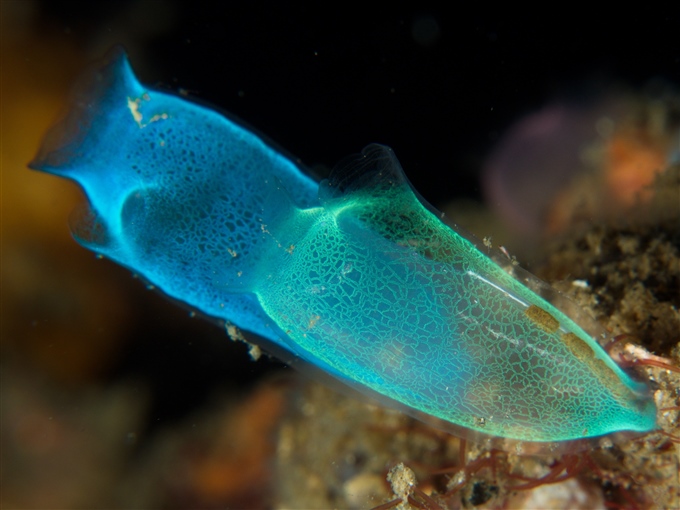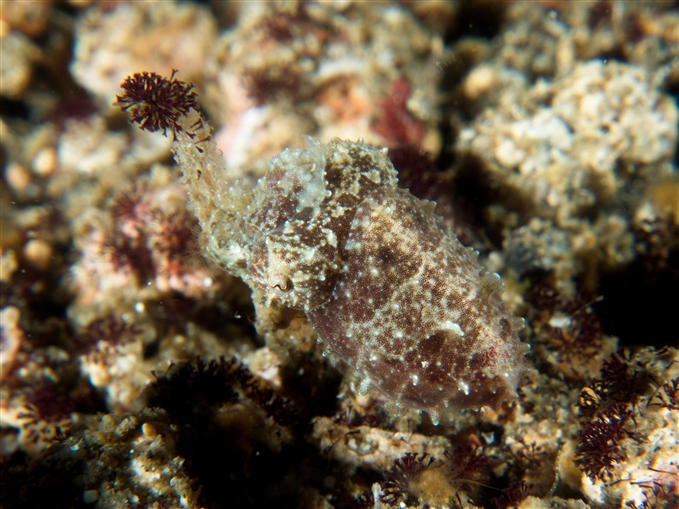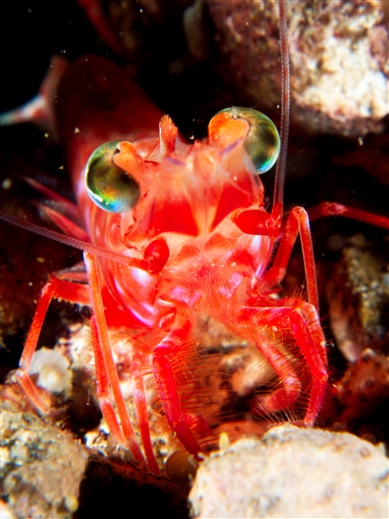For most people, diving in a tropical sea around the equator means a nice and clear water and colorful coral reefs with a vibrant aquatic life. Happy creatures finning around taking their time with searching food and having a social life. That can actually be true but there are some exceptions which may make the diving experience a bit different and sometimes more exciting at the same time. No doubt, the sea’s diversity is beyond human imagination and can shock anyone in a positive way.
Csaba Sellei • muck divers in Lembeh Strait •
Tough TG-4 • INON UWL-H100 28M67 Wide Conversion Lens • PT-056 • Sea&Sea YS-01
When you decide to do muck diving the first impression in the water is usually kind of disappointing. Normally you will not encounter what you have expected. You will most probably not find a spectacular underwater scenery and rather feel that you have just missed the entry point and you may start rethinking the purpose of your actual dive. But be patient and stay focused because the magic world is underneath. Some people may find this environment a little challenging with regards to the diving technic, you need to elaborate and practice your own smooth kicking and trimming and sometimes you will find the need for a certain kind of „acrobatic” position in order to get closer to the subject. Hunting tiny creatures is always the game of curious people who are keen to avoid slap-dash jobs and who are blessed with sharp eyes. The reward always comes... sooner or later.

Csaba Sellei • Tunicatas
OM-D E-M1 • M.Zuiko Digital ED 12-50mm f3.5-6.3 • PT-EP11 • PPO-EP02 • Sea&Sea YS-01
Anyhow, the surrounding water may seem boring but narrowing your focus on the close things will reveal a completely different world. Your eyes (especially trough the mask) might not able to disclose all the tiny details, so take the shot whenever you have the opportunity and later on you can carry out profound analyses on the pictures. The thumb rule of diving is applicable here as well – get close, as close as possible. The depth-of-field is a matter obviously, the range is technically a few millimeters only. But within this range a new universe can appear revealing the complexity of the micro world. A pair of tunicatas display their fragile and spider web like body tissue and let us have a look at their primitive digestion system. Although this species is quite common everywhere in the tropical seas, divers usually do not pay too much attention to them in spite of their very interesting and characteristic pattern. Just take a look!

Csaba Sellei • Dwarf Cuttlefish
OM-D E-M1 • M.Zuiko Digital ED 12-50mm f3.5-6.3 • PT-EP11 • PPO-EP02 • Sea&Sea YS-01
Creeping forward and hovering over the sandy desert and desperately searching the critters we gradually become more and more experienced how to spot them. Just like when you are roaming in a forest searching and picking mushrooms, the same applies for critter hunting. They use their extremely developed camouflage technique which makes them almost totally invisible at first sight. Some of them are very tiny (one centimeter or less if juvenile) but they are still there! Hiding and waiting for the diver to be drifted away. Sometimes you need teamwork to spot the animal because it might not be visible from your position but watching from another direction or applying a different angle of illumination can contour it. Here is a good example, the one centimeter small and shy Dwarf Cuttlefish attaches small organic particles on its arms for better camouflage while imitating the sandy bottom pattern. Do not be disoriented by this cute creature!

Csaba Sellei • Humpback Prawn
OM-D E-M1 • M.Zuiko Digital ED 12-50mm f3.5-6.3
• PT-EP11 • PPO-EP02 • Sea&Sea YS-01
Night crawlers come out after dusk. Some of them do not use camouflage technic because they trust in the dark. But it cannot protect them against the divers’ light. Finding bottom dweller creatures at night is even more challenging because the sharp contours and dramatic change in the amount of light can easily distract the diver’s eye. Moreover, the critter also reacts quickly to the artificial light since they are really susceptible to it. The Humpback Prawn is an ideal example of the typical behavior of a nocturnal animal. When distracted it can rapidly bury in the sand leaving only the eyes exposed. Approach them with care and once you spot one of them prepare your camera and check your settings in advance so you have it ready for the quick action. With mindful approach the photographer can minimize the interaction and can therefore achieve more natural behavior and encourage the pigmy monster to pose longer. Happy hunting!
Csaba Sellei • Decorator Crab
Tough TG-4 • INON UWL-H100 28M67 Wide Conversion Lens • PT-056 • Sea&Sea YS-01
This fellow is a real champion in the hide-away competition. Its name speaks for itself as it is a decorator crab. So it decorates itself by simply gluing sand grains on its skeleton. Very tricky! Normally, they attach a wide variety of debris and they choose the appropriate material according to the proximity of the area where they live. It is really hard to spot them, actually until they move it is almost impossible to distinguish them from the bottom of the sea. Keep swimming slowly and never leave a suspicious place without careful investigation. There might be something there!
Author and photographer: Csaba Sellei
Comments